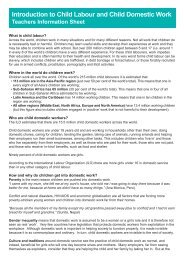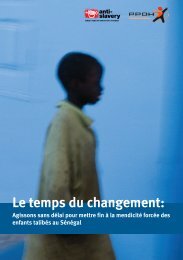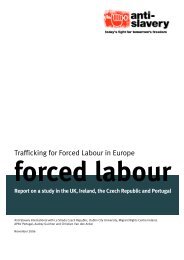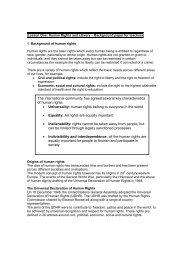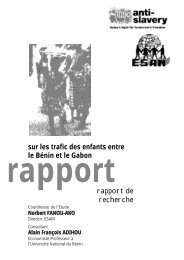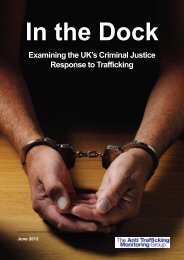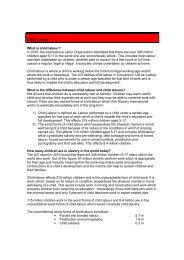In the Dock
Full report (1810.59KB) - Anti-Slavery International
Full report (1810.59KB) - Anti-Slavery International
Create successful ePaper yourself
Turn your PDF publications into a flip-book with our unique Google optimized e-Paper software.
IdentificationThe PSNI is <strong>the</strong> main source of referrals to <strong>the</strong> NRM. Unlike <strong>the</strong> rest of <strong>the</strong> UK, <strong>the</strong>re are no NGOFirst Responders except when it involves children. Whilst referrals can be made by statutoryorganisations such as social services or <strong>the</strong> Gangmaster’s Licensing Authority (GLA), to date noreferrals have been made by ei<strong>the</strong>r. The vast majority of NI referrals to <strong>the</strong> NRM involve sexualexploitation. The PSNI confirmed a dramatic decrease in <strong>the</strong> number of NI trafficking cases referred to<strong>the</strong> NRM in 2012. PSNI data records <strong>the</strong> following number of NRM referrals: 3981 April 2009 - 31 March 2010 20 3991 April 2010 - 31 March 2011 231 April 2011 - 31 March 2012 331 April 2012 - 31 January 2013 8The drop may be attributed in part to structural changes within <strong>the</strong> PSNI in 2011 that included adifferent approach to policing of serious organised crime, including trafficking. The responsibility for<strong>the</strong> identification of victims and NRM referrals now lies with every police officer ra<strong>the</strong>r than withspecialised human trafficking teams. According to <strong>the</strong> PSNI, <strong>the</strong> majority of trafficked persons in NIare identified through targeted and proactive investigations or by self-referral ra<strong>the</strong>r than chanceencounters by frontline officers. However, with every police officer tasked with <strong>the</strong> identification ofvictims it would still be expected that <strong>the</strong> number of referrals would increase ra<strong>the</strong>r than decrease.Conversely, this can also suggest that specialism is needed to identify trafficking and thatidentification on <strong>the</strong> frontline is too complex. This may also be due to a lack of training on traffickingidentification.Though many officers will not encounter a trafficked person during <strong>the</strong>ir police career, <strong>the</strong> ones whodo appear to be ill-equipped to identify <strong>the</strong>m. 400 This drop in referrals is alarming given thatintelligence throughout <strong>the</strong> UK and current NRM patterns in England and Wales do not suggest that<strong>the</strong>re has been a reduction in trafficking. 401 The police continue to assert that demand for sexualservices in NI remains high suggesting that in NI <strong>the</strong>re may be a failure in <strong>the</strong> detection of traffickedpersons resulting in fewer investigations and <strong>the</strong>refore <strong>the</strong> prosecution of traffickers.The number of NRM referrals for alleged labour trafficking is extremely low despite extensive researchcarried out by The Joseph Rowntree Foundation (JRF) in June 2011, indicating that NI has specificmigrant communities vulnerable to labour exploitation. 402 Whilst it was suggested that <strong>the</strong>se cases aremore difficult to detect, it is suspected that trafficked persons are not identified because plannedoperations, in situations that may give rise to labour exploitation, are primarily for <strong>the</strong> enforcement ofimmigration rules. 403The PSNI provides an online e-learning tool for <strong>the</strong> trafficking training of all of its officers. It is notmandatory and to date <strong>the</strong> PSNI do not have statistics on <strong>the</strong> take up of <strong>the</strong> e-learning package. It hasbeen suggested that <strong>the</strong>se omissions in training have had an adverse effect on how police respond totrafficked persons. Reports by participants indicate that trafficked persons are frequently not believedby police at first contact and <strong>the</strong> police have little or no knowledge of what <strong>the</strong>y should do with <strong>the</strong>NRM process. Concerns have been raised about <strong>the</strong> lack of information provided to trafficked persons398A senior police officer in <strong>the</strong> PSNI suggested <strong>the</strong> figures can change slightly due to late and/or false reports.399According to Amnesty NI <strong>the</strong> UKBA provided a figure of 25 referrals in 09/10 at <strong>the</strong> presentation to <strong>the</strong> APGHT on 13th November2012.400One service provider alleges that some victims have not been believed when <strong>the</strong>y self refer at local police stations and in one case<strong>the</strong> police officer asked <strong>the</strong> service provider how to do <strong>the</strong> referral. <strong>In</strong> ano<strong>the</strong>r case <strong>the</strong> police used in appropriate language towards avictim who was told "we know you are a failed asylum seeker".401Home Office, supra note 48.402"Forced Labour in Nor<strong>the</strong>rn Ireland: exploiting vulnerability": The research studied migrants working in <strong>the</strong> fishing, mushroom andcatering industries, as well as Filipino and Romanian migrants and highlighted <strong>the</strong> links between vulnerability and a lack of Englishlanguage skills, limited access to social networks and a lack of local knowledge. See: www.jrf.org.uk.403The OCTF publish an Annual report & Threat Assessment which can be found a: www.dojni.gov.uk/index/media-centre/newsarchive/july-2012/doj-organised-crime-annual-report.pdf.121



